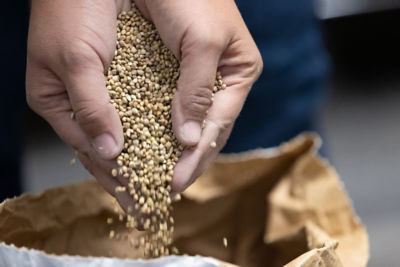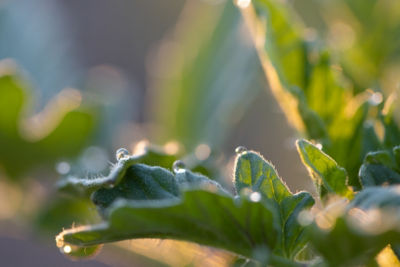Click here to download a PDF version of this spotlight.
» Bacterial, fungal, and fungal-like pathogens cause diseases of leaves, stems, and pods that can result in substantial yield
losses in peas.
» Disease-free seed, sanitation practices, fungicide applications, and disease-resistant varieties are used to help manage foliar
diseases of peas.
DOWNY MILDEW
Downy mildew is most common on peas early in the growing
season when conditions are cool and moist.1 The downy mildew pathogen can cause systemic and localized infections of pea plants.2 Systemically infected plants are stunted, malformed, and usually lighter in color or have a silvery appearance.2,3 The pathogen produces a fuzzy coat of grayish spores (sporangia) on plant surfaces, and systemically infected plants usually die before flowering.
 Figure 1. Growth of the downy mildew pathogen on the undersides of pea leaves. Lyndon Porter, USDA-ARS.
Figure 1. Growth of the downy mildew pathogen on the undersides of pea leaves. Lyndon Porter, USDA-ARS.
Localized infections result in the formation of lesions on leaves, stipules, and pods. Lesions on the leaves are irregular in shape and greenish-yellow to brown on the upper leaf surface. A fluffy (downy), light-gray mold forms on the underside of the leaf(Figure 1). Lesions usually develop first on the lower leaves and then progress upward through the canopy.1,2
The downy mildew pathogen survives as spores in the soil and plant debris, where it can remain viable for up to 15 years.1,2,4 The spores systemically infect young pea seedlings, which then serve as sources of inoculum for other plants in the field.3,4 The disease is spread from plant to plant by wind and splashing rain, and cool, moist conditions favor disease development. Temperatures between 40° and 46°F and relative humidity levels over 95% are optimal. At least 4 hours of leaf wetness are required for infection to occur.2,3,4
Downy mildew is managed through the use of resistant varieties, sanitation, and fungicides. There are several forms of resistance to downy mildew in peas, but no pea variety is completely immune.1,2,3,4 Deep tillage and long-term crop rotation can help reduce inoculum levels. Seed treatment with fungicides effective against oomycetes can help protect emerging seedlings from infection. Acyl analine fungicides, such as metalaxyl, have been the most effective against downy mildew. However, resistance to these fungicides occurs in some areas, and alternating or combining applications with other fungicides belonging to other classes is recommended.1,2,3,4
POWDERY MILDEW
Powdery mildew of pea is common worldwide and occurs most often late in the season. Early infections can substantially reduce yields and lower seed quality.1,3,4 The initial symptoms of powdery mildew include small, discolored spots on the upper surfaces of leaves, usually starting in the lower canopy. The lesions expand and become covered with gray to white, powdery fungal colonies, which are initially easy to rub off. As colonies enlarge, the leaves become chlorotic. The lesions can coalesce, eventually covering all of the above-ground plant parts. Severe infections result in the stunting of growth and possibly plant death. Infection of the pods can cause seed discoloration and negatively affect seed flavor.1,2,3,4,5
The fungi that causes powdery mildew can survive on seed, in the field on infested crop debris, and on other hosts, including alfalfa, vetch, lupine, and lentil. The pathogen is spread by windblown spores. The disease is favored by warm temperatures (50° to 86°F) and high humidity. Cool nights that promote dew formation also favor the development of powdery mildew. The disease is usually less severe in areas with high rainfall or where sprinkler irrigation is used. Greater yield losses can occur with later plantings.1,2,3,4,5
Early planting can help plants mature before powdery mildew develops to the point where it affects yield. Overhead irrigation can also help reduce the severity of powdery mildew. Rotation away from pea can lower inoculum levels in the field, but the long-distance spread of windblown spores can negate the effectiveness of crop rotation in large pea production areas.2 Two resistance genes (er-1 and er-2), as well as some modifying resistance genes, are available for use against powdery mildew. The er-2 gene is expressed primarily in the leaves and becomes less effective under high disease pressure.2,4 Foliar fungicides applied at the early stages of disease development can help manage powdery mildew. Sulfur based fungicides and DMI fungicides are usually recommended.2,3
ASCOCHYTA DISEASES
Three related fungal pathogens cause three similar pea diseases, Ascochyta blight, Ascochyta foot rot and black stem, and Ascochyta leaf and pod spot. Of these three diseases, Ascochyta blight is the most widespread and damaging, capable of causing yield losses of 10 to 75%.2,4
 Figure 2. Ascochyta blight lesions on pea leaves. Mary Burrows, Montana State University, Bugwood.org
Figure 2. Ascochyta blight lesions on pea leaves. Mary Burrows, Montana State University, Bugwood.org
The symptoms of blight and foot rot are similar. Initial symptoms include small, dark irregular flecks on leaves, pods, and stems. These lesions enlarge and become round to oval with concentric rings of alternating shades of light and dark brown. The lesions coalesce, causing the blight symptoms.2,3 Stem lesions occur mostly near the nodes and can enlarge to the point where they girdle the stem. Pod lesions become circular to irregular in shape, brown to purplish-black, and can result in seed discoloration. Root infections occur mostly on the upper taproot and hypocotyl and can cause damping-off or stunting of seedlings. The symptoms of leaf and pod spot include lesions on leaves, stems, and pods that are 1/5 to 1/3 inches (5 to 8 mm) in diameter, slightly sunken, and tan in color with a dark, distinct borders. Lesions on leaves and pods are circular to oval, and stem lesions are elongated. Dark spots (fungal fruiting bodies) form in the centers of the lesions.1,2
The fungi that cause Ascochyta blight and Ascochyta foot rot and black stem survive in infested crop debris and in the soil for many years. They can also be seedborne. Ascochyta blight is spread by windblown and water splashed spores. A minimum of two hours of leaf wetness are needed for spore germination and infection. Temperatures of 41° to 86°F favor the development of Ascochyta blight.2,3,4 The leaf and pod spot pathogen can overwinter in crop debris but does not survive well in the field. The pathogen is primarily seedborne. Leaf and pod spot is favored by cool, wet conditions and short pearotations. Initial infections are the result of spores spread by splashing and windblown water. Infections later in the seasonusually result from the dispersal of windblown spores.1,2,3
The Ascochyta diseases are managed by avoiding fields with a history of the diseases, the use of disease-free seed, and seed treatments. Avoiding overhead irrigation or scheduling
overhead irrigation to promote rapid drying of the foliage can reduce disease spread and severity. A three to four-year crop rotation can help manage Ascochyta leaf and pod spot. Racespecific resistance is available for leaf and pod spot, and there is some resistance available for Ascochyta blight. The use of foliar fungicides can help manage these diseases.1,2,3
BACTERIAL BLIGHT
Bacterial blight of peas occurs worldwide and can substantially reduce yields when severe. Seven different races of the pathogen have been identified with races 1 to 5 present in the U.S.2,4 Symptoms of bacterial blight develop on all aboveground parts. The initial symptoms are small, shiny, watersoaked spots. As they enlarge, the spots turn brown and develop into angular shaped lesions. Lesions on the stem can coalesce and girdle the stem. The pathogen can also infect flowers, pods, and seeds.2,4,5
The bacterial pathogen is seedborne and can survive in seed for up to three years. Infected seed is the primary means of long-distance spread of this disease. The pathogen can survive in infested debris for over a year, but it does not survive well in soil.2,4Pea seedlings become infected as they germinate and emerge from the soil. The pathogen can colonize and survive on the surfaces of other crop and weed hosts, which can serve as sources of inoculum during periods of warm, wet weather. The pathogen is spread from plant to plant in splashing water, on machinery, and the clothing of workers moving through the field, and in irrigation drainage water.2,3,4,5
Management strategies for bacterial blight include the use of disease-free seed and sanitation practices. Growers should avoid moving equipment and workers from infected fields to healthy fields. Equipment and workers should not enter fields when plants are wet. Sanitize equipment and clothing after they have been in a field with diseased plants. Rotate away from peas for at least two years after the disease has occured.2,3,4 Genes for race-specific and nonspecific types of resistance are available. Race-specific resistance can be very effective if the genes used are appropriate for races of the pathogen that are present.2,3,4
SOURCES
1 Hagedorn, D. 1991. Handbook of pea diseases. University of Wisconsin Extension. Publication A1167.
2 Kraft, J. and Pfleger, F. 2001. Compendium of pea diseases and pests, second edition. American Phytopathological Society. St. Paul.
3 Koike, S., Gladders, P., and Paulus, A. 2007. Vegetable diseases: A color handbook. Academic Press. Boston.
4 Grünwald, N. J., Chen, W., and Larsen, R. C. 2004. Pea diseases and their management. Pages 301-331 in: Diseases of Fruits and Vegetables: Volume II: Diagnosis and Management. S. A. M. H. Naqvi, ed. Springer Netherlands, Dordrecht.
5 Markell, S., Pasche, J., and Porter, L., 2016. Pea Disease Diagnostic Series. NDSU, PP1790.
ADDITIONAL INFORMATION
For additional agronomic information, please contact your local seed representative.
Performance may vary from location to location and from year to year, as local growing, soil and weather conditions may vary. Growers should evaluate data from multiple locations and years whenever possible and should consider the impacts of these conditions on the grower’s fields. The recommendations in this article are based upon information obtained from the cited sources and should be used as a quick reference for information about pea production. The content of this article should not be substituted for the professional opinion of a producer, grower, agronomist, pathologist and similar professional dealing with this specific crop.
BAYER GROUP DOES NOT WARRANT THE ACCURACY OF ANY INFORMATION OR TECHNICAL ADVICE PROVIDED HEREIN AND DISCLAIMS ALL LIABILITY FOR ANY CLAIM
INVOLVING SUCH INFORMATION OR ADVICE.
9062_S1 Published 10-14-2020
Bayer, Bayer Cross Design, and Seminis® are registered trademarks of Bayer Group. All other trademarks are property of their respective owners. © 2020 Bayer Group. All rights reserved.




